FIAT BARCHETTA 2003 1.G Owners Manual
Manufacturer: FIAT, Model Year: 2003, Model line: BARCHETTA, Model: FIAT BARCHETTA 2003 1.GPages: 170, PDF Size: 3.55 MB
Page 111 of 170
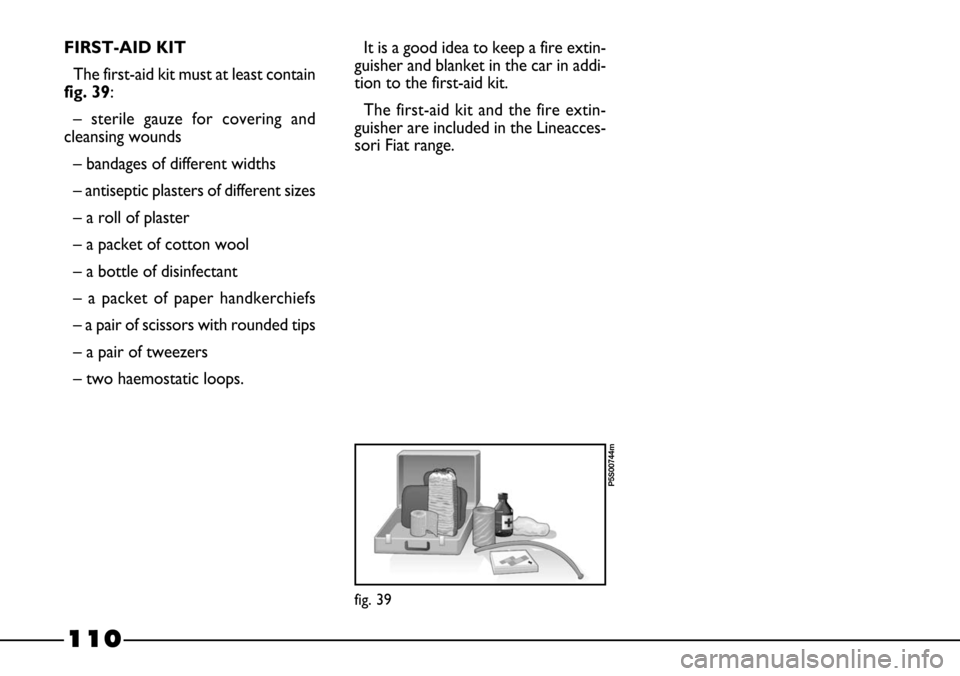
110
FIRST-AID KIT
The first-aid kit must at least contain
fig. 39:
– sterile gauze for covering and
cleansing wounds
– bandages of different widths
– antiseptic plasters of different sizes
– a roll of plaster
– a packet of cotton wool
– a bottle of disinfectant
– a packet of paper handkerchiefs
– a pair of scissors with rounded tips
– a pair of tweezers
– two haemostatic loops.It is a good idea to keep a fire extin-
guisher and blanket in the car in addi-
tion to the first-aid kit.
The first-aid kit and the fire extin-
guisher are included in the Lineacces-
sori Fiat range.
fig. 39
P5S00744m
Page 112 of 170
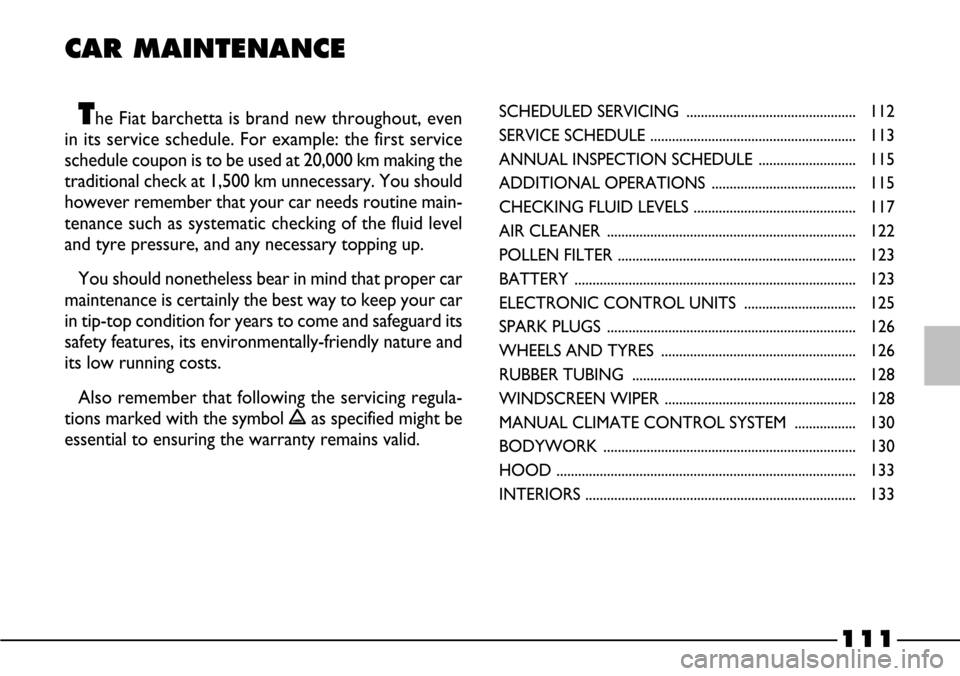
111
CAR MAINTENANCE
The Fiat barchetta is brand new throughout, even
in its service schedule. For example: the first service
schedule coupon is to be used at 20,000 km making the
traditional check at 1,500 km unnecessary. You should
however remember that your car needs routine main-
tenance such as systematic checking of the fluid level
and tyre pressure, and any necessary topping up.
You should nonetheless bear in mind that proper car
maintenance is certainly the best way to keep your car
in tip-top condition for years to come and safeguard its
safety features, its environmentally-friendly nature and
its low running costs.
Also remember that following the servicing regula-
tions marked with the symbol ∑as specified might be
essential to ensuring the warranty remains valid.SCHEDULED SERVICING ............................................... 112
SERVICE SCHEDULE ......................................................... 113
ANNUAL INSPECTION SCHEDULE ........................... 115
ADDITIONAL OPERATIONS ........................................ 115
CHECKING FLUID LEVELS ............................................. 117
AIR CLEANER ..................................................................... 122
POLLEN FILTER .................................................................. 123
BATTERY .............................................................................. 123
ELECTRONIC CONTROL UNITS ............................... 125
SPARK PLUGS ..................................................................... 126
WHEELS AND TYRES ...................................................... 126
RUBBER TUBING .............................................................. 128
WINDSCREEN WIPER ..................................................... 128
MANUAL CLIMATE CONTROL SYSTEM ................. 130
BODYWORK ...................................................................... 130
HOOD ................................................................................... 133
INTERIORS ........................................................................... 133
Page 113 of 170
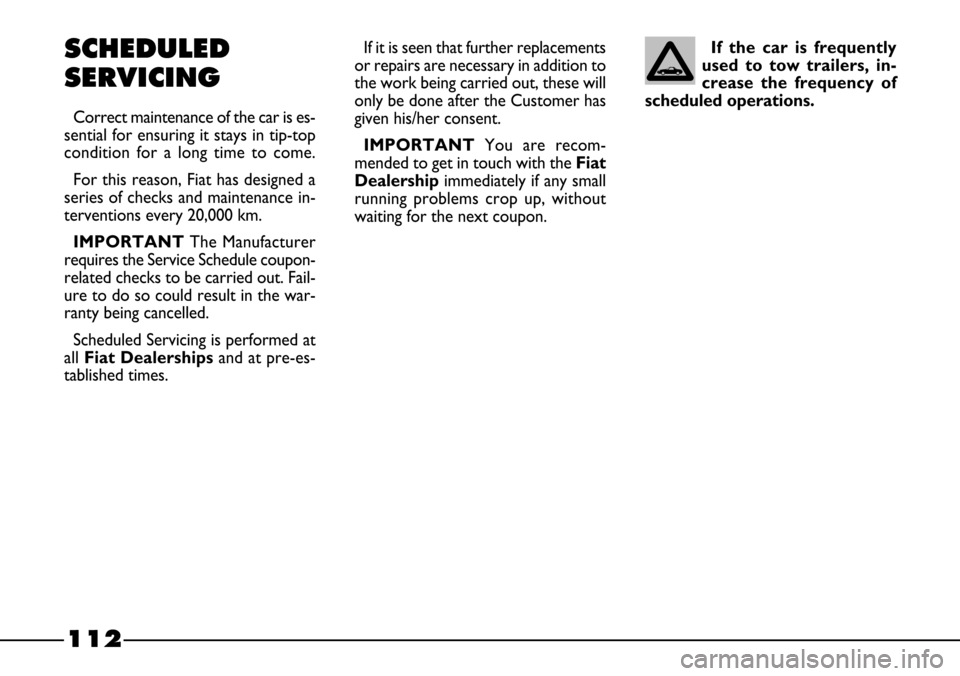
112
SCHEDULED
SERVICING
Correct maintenance of the car is es-
sential for ensuring it stays in tip-top
condition for a long time to come.
For this reason, Fiat has designed a
series of checks and maintenance in-
terventions every 20,000 km.
IMPORTANTThe Manufacturer
requires the Service Schedule coupon-
related checks to be carried out. Fail-
ure to do so could result in the war-
ranty being cancelled.
Scheduled Servicing is performed at
all Fiat Dealerships and at pre-es-
tablished times.If it is seen that further replacements
or repairs are necessary in addition to
the work being carried out, these will
only be done after the Customer has
given his/her consent.
IMPORTANT You are recom-
mended to get in touch with the Fiat
Dealershipimmediately if any small
running problems crop up, without
waiting for the next coupon.If the car is frequently
used to tow trailers, in-
crease the frequency of
scheduled operations.
Page 114 of 170
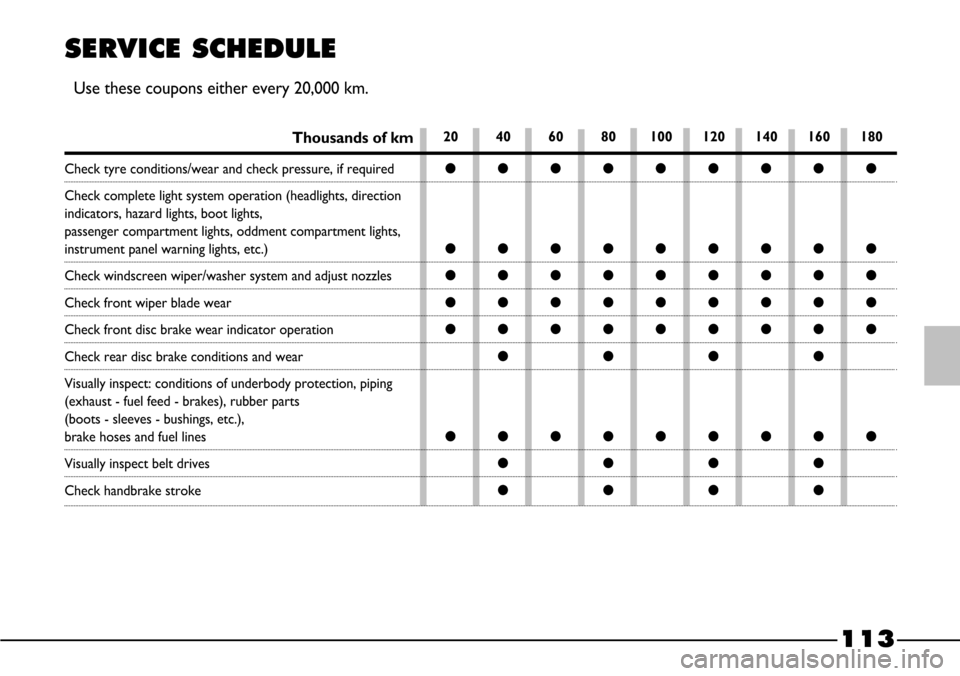
113
SERVICE SCHEDULE
Use these coupons either every 20,000 km.
Thousands of km20 40 60 80 100 120 140 160 180
Check tyre conditions/wear and check pressure, if required
Check complete light system operation (headlights, direction
indicators, hazard lights, boot lights,
passenger compartment lights, oddment compartment lights,
instrument panel warning lights, etc.)
Check windscreen wiper/washer system and adjust nozzles
Check front wiper blade wear
Check front disc brake wear indicator operation
Check rear disc brake conditions and wear
Visually inspect: conditions of underbody protection, piping
(exhaust - fuel feed - brakes), rubber parts
(boots - sleeves - bushings, etc.),
brake hoses and fuel lines
Visually inspect belt drives
Check handbrake stroke
ççççççççç
ççççççççç
ççççççççç
ççççççççç
ççççççççç
çççç
ççççççççç
çççç
çççç
Page 115 of 170
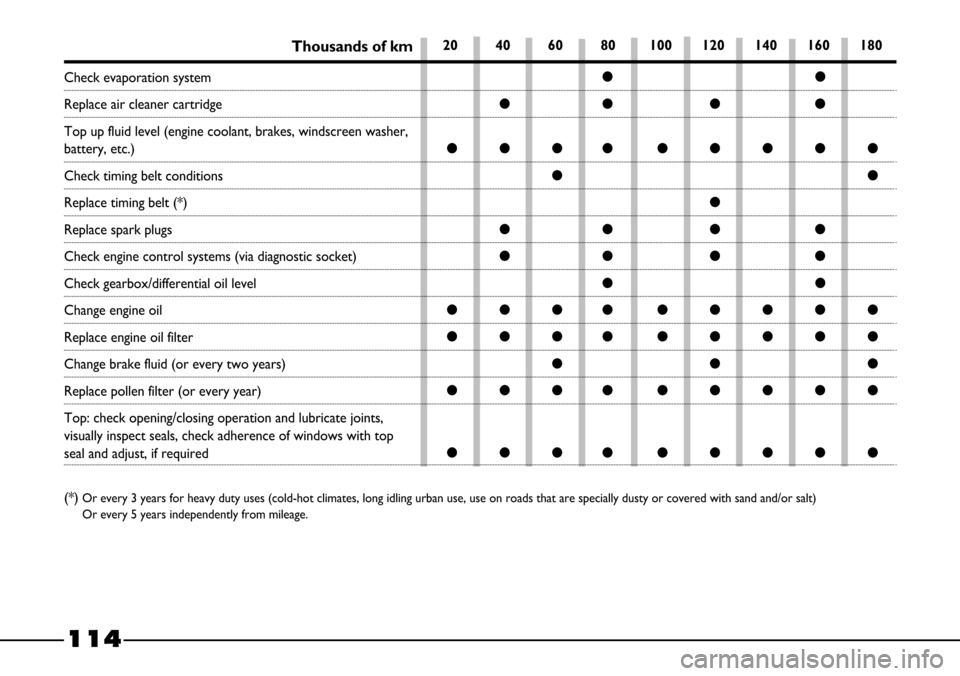
114
(*) Or every 3 years for heavy duty uses (cold-hot climates, long idling urban use, use on roads that are specially dusty or covered with sand and/or salt)
Or every 5 years independently from mileage.
Thousands of km
çç
çç ç ç
çççç ççççç
çç
ç
çç ç ç
çç ç ç
çç
çççç ççççç
çççç ççççç
ççç
çççç ççççç
çççç ççççç
20 40 60 80 100 120 140 160 180
Check evaporation system
Replace air cleaner cartridge
Top up fluid level (engine coolant, brakes, windscreen washer,
battery, etc.)
Check timing belt conditions
Replace timing belt (*)
Replace spark plugs
Check engine control systems (via diagnostic socket)
Check gearbox/differential oil level
Change engine oil
Replace engine oil filter
Change brake fluid (or every two years)
Replace pollen filter (or every year)
Top: check opening/closing operation and lubricate joints,
visually inspect seals, check adherence of windows with top
seal and adjust, if required
Page 116 of 170
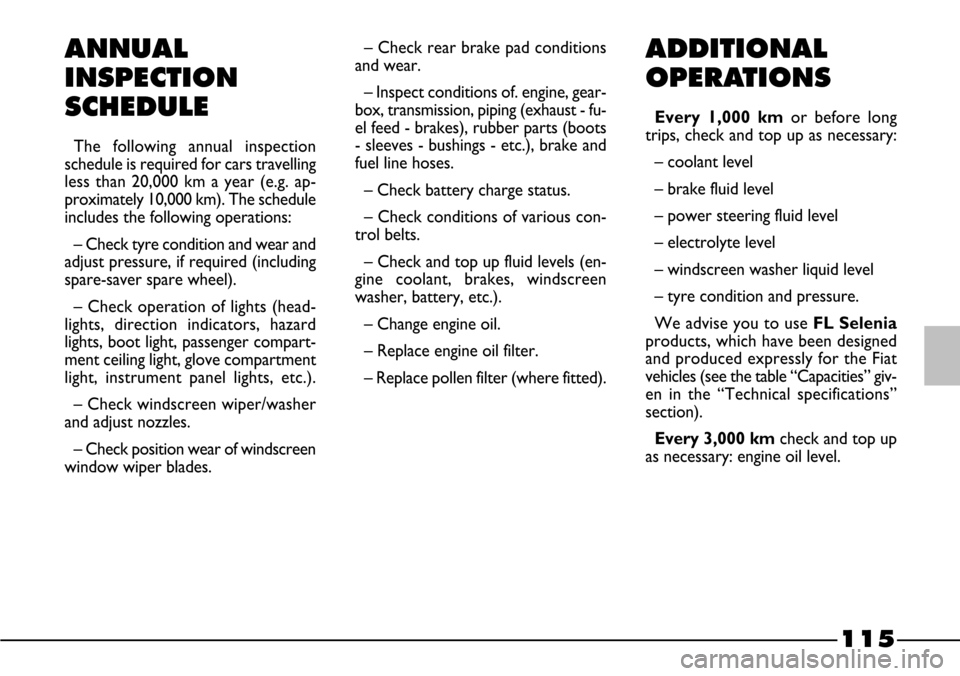
115
ANNUAL
INSPECTION
SCHEDULE
The following annual inspection
schedule is required for cars travelling
less than 20,000 km a year (e.g. ap-
proximately 10,000 km). The schedule
includes the following operations:
– Check tyre condition and wear and
adjust pressure, if required (including
spare-saver spare wheel).
– Check operation of lights (head-
lights, direction indicators, hazard
lights, boot light, passenger compart-
ment ceiling light, glove compartment
light, instrument panel lights, etc.).
– Check windscreen wiper/washer
and adjust nozzles.
– Check position wear of windscreen
window wiper blades.
ADDITIONAL
OPERATIONS
Every 1,000 kmor before long
trips, check and top up as necessary:
– coolant level
– brake fluid level
– power steering fluid level
– electrolyte level
– windscreen washer liquid level
– tyre condition and pressure.
We advise you to use FL Selenia
products, which have been designed
and produced expressly for the Fiat
vehicles (see the table “Capacities” giv-
en in the “Technical specifications”
section).
Every 3,000 km check and top up
as necessary: engine oil level. – Check rear brake pad conditions
and wear.
– Inspect conditions of. engine, gear-
box, transmission, piping (exhaust - fu-
el feed - brakes), rubber parts (boots
- sleeves - bushings - etc.), brake and
fuel line hoses.
– Check battery charge status.
– Check conditions of various con-
trol belts.
– Check and top up fluid levels (en-
gine coolant, brakes, windscreen
washer, battery, etc.).
– Change engine oil.
– Replace engine oil filter.
– Replace pollen filter (where fitted).
Page 117 of 170
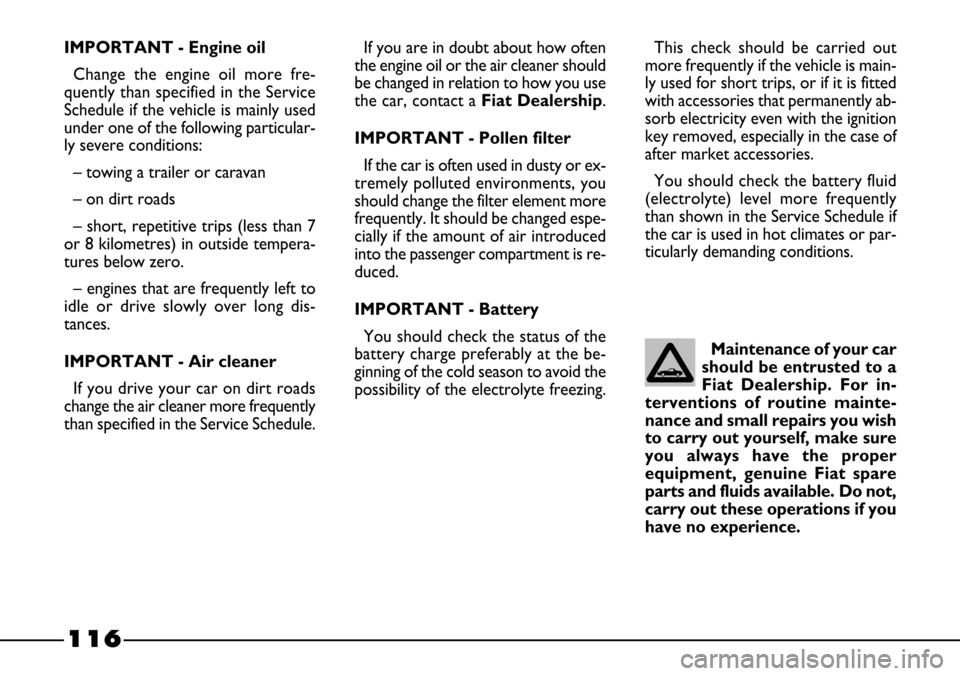
116
This check should be carried out
more frequently if the vehicle is main-
ly used for short trips, or if it is fitted
with accessories that permanently ab-
sorb electricity even with the ignition
key removed, especially in the case of
after market accessories.
You should check the battery fluid
(electrolyte) level more frequently
than shown in the Service Schedule if
the car is used in hot climates or par-
ticularly demanding conditions. IMPORTANT - Engine oil
Change the engine oil more fre-
quently than specified in the Service
Schedule if the vehicle is mainly used
under one of the following particular-
ly severe conditions:
– towing a trailer or caravan
– on dirt roads
– short, repetitive trips (less than 7
or 8 kilometres) in outside tempera-
tures below zero.
– engines that are frequently left to
idle or drive slowly over long dis-
tances.
IMPORTANT - Air cleaner
If you drive your car on dirt roads
change the air cleaner more frequently
than specified in the Service Schedule.If you are in doubt about how often
the engine oil or the air cleaner should
be changed in relation to how you use
the car, contact a Fiat Dealership.
IMPORTANT - Pollen filter
If the car is often used in dusty or ex-
tremely polluted environments, you
should change the filter element more
frequently. It should be changed espe-
cially if the amount of air introduced
into the passenger compartment is re-
duced.
IMPORTANT - Battery
You should check the status of the
battery charge preferably at the be-
ginning of the cold season to avoid the
possibility of the electrolyte freezing.Maintenance of your car
should be entrusted to a
Fiat Dealership. For in-
terventions of routine mainte-
nance and small repairs you wish
to carry out yourself, make sure
you always have the proper
equipment, genuine Fiat spare
parts and fluids available. Do not,
carry out these operations if you
have no experience.
Page 118 of 170
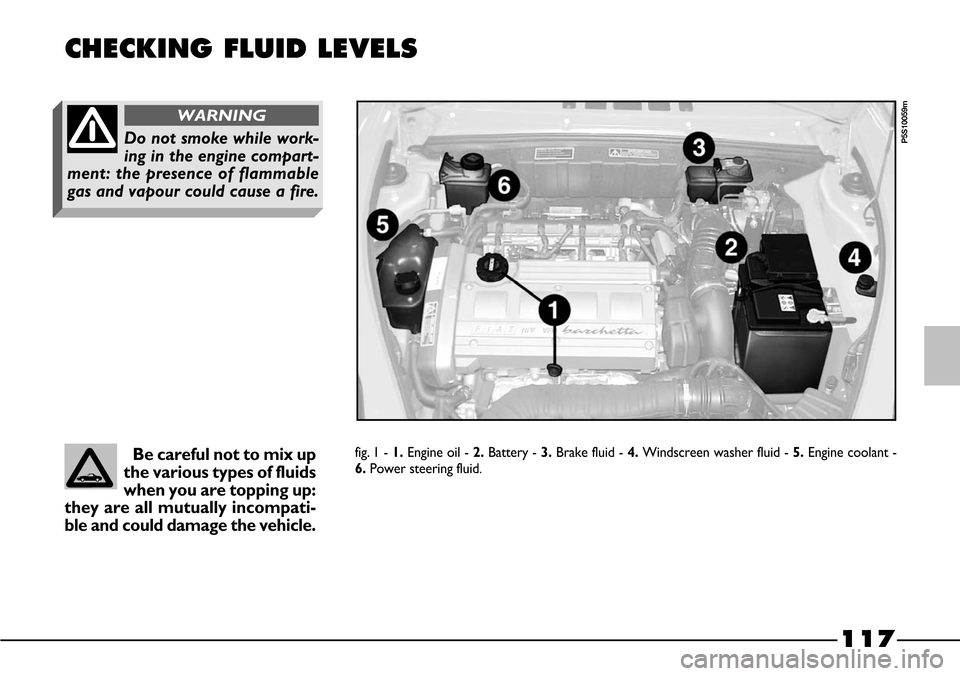
117
CHECKING FLUID LEVELS
P5S10059m
Be careful not to mix up
the various types of fluids
when you are topping up:
they are all mutually incompati-
ble and could damage the vehicle.fig. 1 -1. Engine oil - 2. Battery - 3. Brake fluid - 4. Windscreen washer fluid - 5. Engine coolant -
6. Power steering fluid.
Do not smoke while work-
ing in the engine compart-
ment: the presence of flammable
gas and vapour could cause a fire.
WARNING
Page 119 of 170
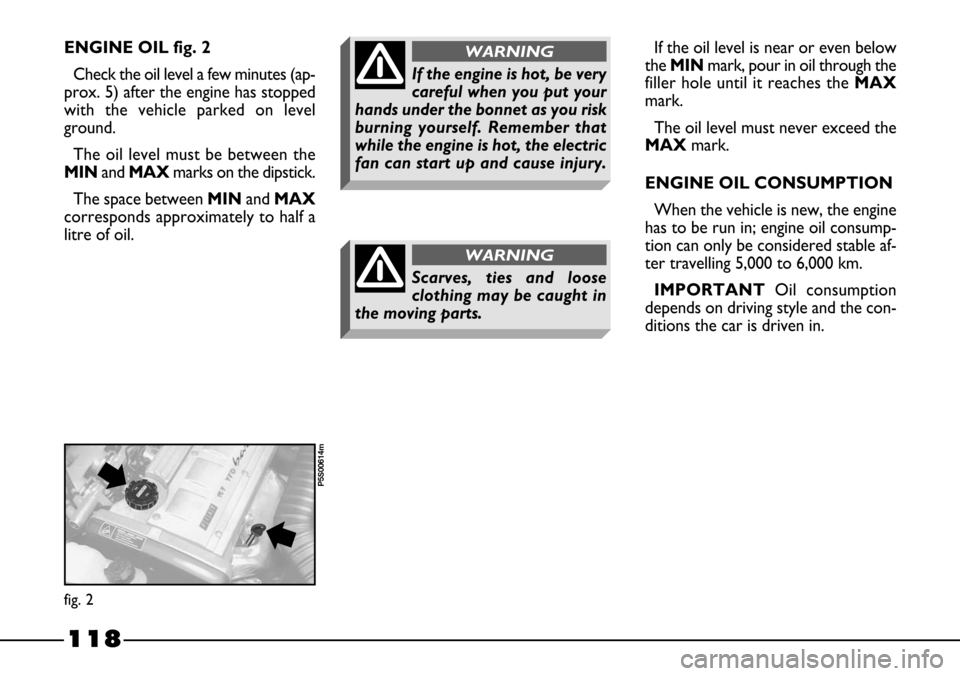
118
ENGINE OIL fig. 2
Check the oil level a few minutes (ap-
prox. 5) after the engine has stopped
with the vehicle parked on level
ground.
The oil level must be between the
MINand MAXmarks on the dipstick.
The space between MINand MAX
corresponds approximately to half a
litre of oil.If the oil level is near or even below
theMIN mark, pour in oil through the
filler hole until it reaches the MAX
mark.
The oil level must never exceed the
MAXmark.
ENGINE OIL CONSUMPTION
When the vehicle is new, the engine
has to be run in; engine oil consump-
tion can only be considered stable af-
ter travelling 5,000 to 6,000 km.
IMPORTANTOil consumption
depends on driving style and the con-
ditions the car is driven in.
fig. 2
P5S00614m
If the engine is hot, be very
careful when you put your
hands under the bonnet as you risk
burning yourself. Remember that
while the engine is hot, the electric
fan can start up and cause injury.
WARNING
Scarves, ties and loose
clothing may be caught in
the moving parts.
WARNING
Page 120 of 170
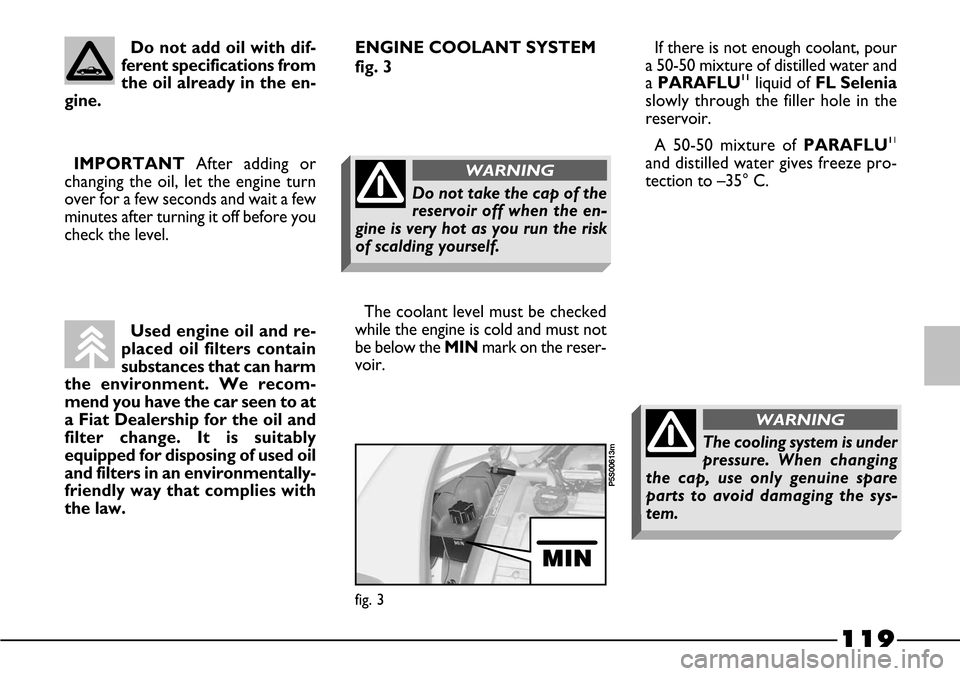
119
Used engine oil and re-
placed oil filters contain
substances that can harm
the environment. We recom-
mend you have the car seen to at
a Fiat Dealership for the oil and
filter change. It is suitably
equipped for disposing of used oil
and filters in an environmentally-
friendly way that complies with
the law.ENGINE COOLANT SYSTEM
fig. 3If there is not enough coolant, pour
a 50-50 mixture of distilled water and
a PARAFLU
11liquid of FL Selenia
slowly through the filler hole in the
reservoir.
A 50-50 mixture of PARAFLU
11
and distilled water gives freeze pro-
tection to –35° C. Do not add oil with dif-
ferent specifications from
the oil already in the en-
gine.
IMPORTANT After adding or
changing the oil, let the engine turn
over for a few seconds and wait a few
minutes after turning it off before you
check the level.
fig. 3
P5S00613m
The coolant level must be checked
while the engine is cold and must not
be below the MINmark on the reser-
voir.
Do not take the cap of the
reservoir off when the en-
gine is very hot as you run the risk
of scalding yourself.
WARNING
The cooling system is under
pressure. When changing
the cap, use only genuine spare
parts to avoid damaging the sys-
tem.
WARNING